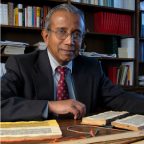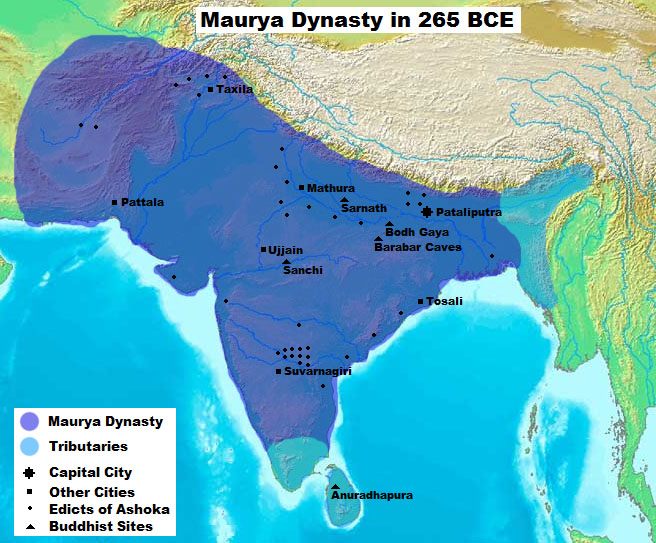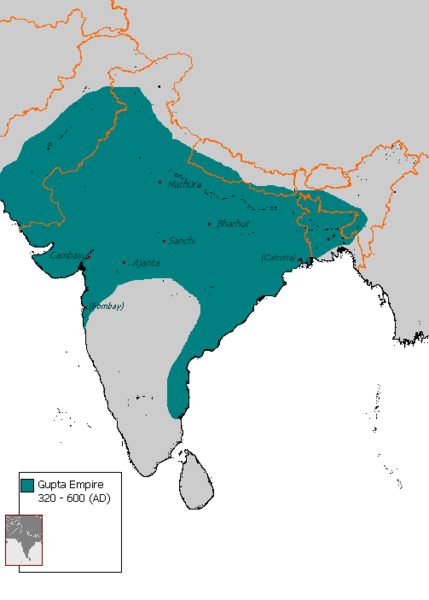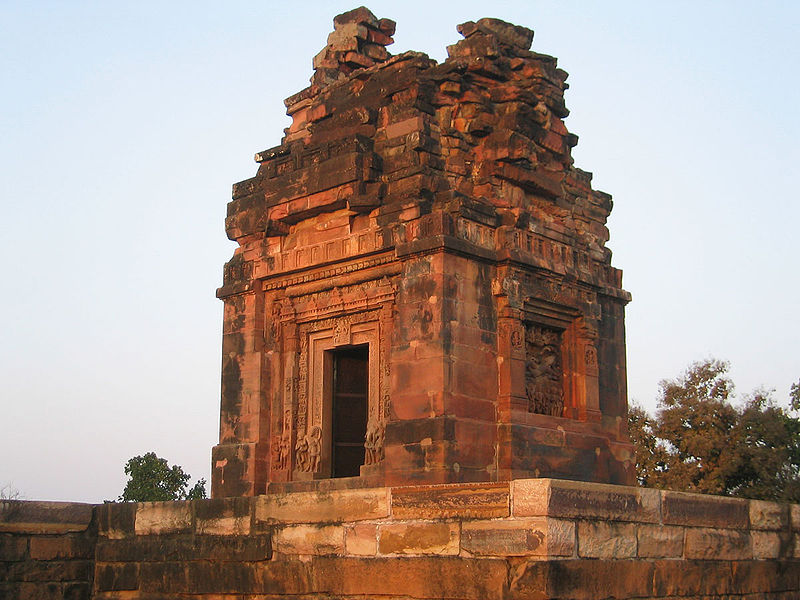Ancient, or Classical, India (300s BC-400s AD) was a seminal period in history. Nearly everything that is associated with classical India, the epics such as the the Rāmāyaṇa and the Mahābhārata, and great temple architecture, came out of this period. Great kings like Aśoka left their mark on the classical world. Moreover, this was the period when oral traditions were written down, and the classical Vedic religion began to take on a form that we understand as Hindusim.
Guest Patrick Olivelle from UT’s Department of Asian Studies describes the Maurya and Gupta Empires and the flourishing period of South Asian history “between the empires.”
Guests
 Patrick OlivelleProfessor Emeritus, Department of Asian Studies, University of Texas at Austin
Patrick OlivelleProfessor Emeritus, Department of Asian Studies, University of Texas at Austin
Hosts
 Christopher RosePostdoctoral Fellow, Institute for Historical Studies, The University of Texas at Austin
Christopher RosePostdoctoral Fellow, Institute for Historical Studies, The University of Texas at Austin
What was notable about this period in Indian history, and which are the two empires that we’re going to be talking about today?
The two empires are the Maurya Empire, which is the first, from about the 4th-3rd century BC and the Gupta Empire, and the second is the Gupta Empire, which goes from the 4th century to the 5th century AD. This is a period of about 600-700 years. I have called this period the “period between the empires.” That has been the seminal period in Indian history: everything that you associate with India, whether it is literature, religion, or architecture comes from this period. The major philosophical traditions, the major works were written during this period. If you talk about the yoga s?tras, which are the foundational texts of yoga, they were written during this period. Almost all of the Buddhist canonical literatures were written during this period.
So, you have this period that is so seminar that most of what we associate with India–take the major temples and architectural monuments, all coming from this period.

Chronologically, we’re going to begin in the 4th century, BC. What was it that propelled the first of these two empires to rise? What was going on, and how did they consolidate power?
We know very little about this period. In all likelihood, there was the final incursion of Alexander the Great coming into northwest India, and he defeated many of the kings, which seemed to have left a power vacuum in northern India. Immediately after Alexander withdrew, Chandragupta, probably a local king, rose to power and took his capital in eastern India. Today it’s called Patna, in those days it was called Pataliputra. He, his son, and his grandson who is the great A?oka, consolidated power over a vast area of northern India. A?oka actually brought it all the way west to Afghanistan and south to what is today southern India-Karnataka and that area where Mysore is located. This is where probably the largest empire before the British was located–almost all of India, but going into Afghanistan and Pakistan was under of the power of this single king, A?oka.

That’s quite an accomplishment, particularly in the pre-modern era, for an empire to be able to rule over such a large territory. How did they control that area politically, militarily, and economically?
It is very unclear. It is clear that he did not control every inch of this territory. He controlled, I think, the major trade routes, the major population centers. How we know that he controlled these areas is that he left the first inscriptions of India, both pillar and rock inscriptions. We have found them in Afghanistan–we have a bilingual inscription in Greek and Aramaic, which is in Kandahar. We have inscriptions in southern India, we have inscriptions all around what is today the eastern seaboard as well as the western seaboard, and going all the way into what is today Nepal. So, he left his fingerprints all over this area with these inscriptions.

What are written on these inscriptions? I know, for example, that one of the pillars appears on the Indian 10-Rupee note, so clearly they’re very famous.
And the capitals, the lion capital is on the Indian currency and on the Indian flag. What is significant is that these are the first written documents from ancient India. Ancient Indian civilizations operated for almost a thousand years without, as far as we know, something written. If it existed, we don’t have it. These are the first writings from India. We have texts predating it, but these were all oral texts. What is interesting about these particular inscriptions is that I have called them “letters.” They have a letter mode: he is writing to his people, he is writing counselors–his officials–and they all preach the gospel of morality, especially of not killing–ahimsa. This is the earliest expression of that non-injury, not killing.
So, here’s an emperor who killed a lot of people to come to power, and he became a Buddhist. In his new-found faith, he found this “doing good, being kind, not killing,” as the central ethical principal.
Do we have any sense of what kind of King he was, other than these written texts? Do we know how long he ruled?
Yes, we know he ruled from 268-233 BC, thereabouts, and we know that he was a king who was very powerful. He says in his inscriptions that, “Even though I have given up the sword, I still have it!” This is something very interesting. He had a bureaucracy that was quite large, and we have very technical terms for the various people in his bureaucracy, so it must have been very extensive. He had a chancery in his capital, Pataliputra, which produced a lot of documents. What I think is that what we find here would be a very small percentage of what he actually wrote. These were probably originated as written documents that were written on paper of some kind, and later anthologized–brought together–and then inscribed on stone. So, he must have had a chancery that sent these things. He also boasts that he sent doctors and missionaries to countries outside of India. He talks about Egypt, Antioch, Rome, Sri Lanka, where he sent his ambassadors. It was a multi-pronged attempt to influence–I think what we can say is to influence world affairs.
He thought that his main word, which is a central word in Indian religion called “dharma” and he defined it ethically, he thought that if everyone followed dharma, there would be world peace.
Well, that’s been a goal of many over the centuries-
-exactly!
Do we know how the empire proceeded after A?oka’s rule?
Not much. I think his children were not as good, or not as able as he was, and very soon, by the beginning of the second century BC–185 is the normal year given–his grandson was assassinated, and then the empire collapsed.

So, what was going on between the fall of the Maurya empire and the rise of the Gupta empire?
There were many small, regional kingdoms. Some of them we know about because of numismatic evidence–we have coins issued by these kings. At this time, the first century BC, we have incursions into India by both the Bactrian kingdoms–the Greco-Bactrian kingdoms that was left behind by Alexander the Great in what is today Iran and Afghanistan. We have incursions from two groups of central Asian nomadic fighters: the ??kas, who came in the 1st century before Christ, and the Kushanas who were much larger, and had quite an extensive empire in northern and central India, who came in the first century after Christ. It was the Guptas who finally defeated the Kushanas and took over their empire. The Gupta empire went from what is today Bengal and went to Pakistan, but on a narrow line across India, and did not go south. So, it was much smaller in extent than A?oka’s.
You mentioned that the beginning of the interview that you viewed this period as between the two empires. What did the Gupta Empire accomplish that mirrored the Maurya’s accomplishments?
Strangely enough, the Guptas occupied the same capital as the Maurya, Pataliputra–the same place. And the very first emperor, Chandragupta I, took on the same name as the very first emperor of the Mauryas. This was not accidental, I think. They were trying to lay claim to the old Maurya empire and legitimize their own imperial ambitions and dynasty through connections to it. What happened during the Gupta period was that the Gupta kingdom was a very rich kingdom. We have the largest number of gold coins coming from this period. Gold was abandoned. It was a time when art and literature flourished in India. Some of the major poets of India, such as K?lid?sa, who has been called the “Shakespeare of India” wrote during this period. Much of what we call the age of classical architecture in India comes from this period. So, it was a time of great cultural activity, not just political.
What sorts of literature were being produced? You mentioned K?lid?sa, India’s Shakespeare, so, perhaps you could familiarize our listeners a little bit with K?lid?sa and his works.
K?lid?sa was both a poet as well as a playwright. He has written several plays, Sanskrit dramas, as well as epic poems. His work influenced many of the 19th century–Goethe and others–who saw him as one of the greatest poets of the world. But during this time, it was not just K?lid?sa who wrote. Before him, a few centuries before him, you find the great Sanskrit epics: the R?m?ya?a and the Mah?bh?rata, two of the major cultural monuments of India. Nobody knows exactly when they were produced, but a general view is that they are from between the 1st century BC and about the 3rd century AD. Its final form may have taken place under the Guptas. The Mah?bh?rata itself goes into about twenty to thirty volumes–it’s huge. The R?m?ya?a is about a third of the size of the Mah?bh?rata. And these are two of the largest epic poems in the world, much larger than Homer.

Given that these both have religious significance, is this a time that we also begin to see some crystallization within the Vedic religious practice?
This is the time when the old Vedic religious practice gradually gives way to what we would recognize today as Hinduism. There were no temples before this period in India. We think of India as the land of temples, but there was no monumental architecture devoted to Hindu religious practice. The earliest monumental architecture of a religious nature comes from the Buddhist side, not from the Hindu side. It is during this time period that we see the first.
Some of the major Hindu philosophical treatises would be written during this period–I talked about the yoga s?tras. And many of the others, dealing with crystallization of Upani?adic thought about Brahma, about the whole world is one, and the whole world of multiplicity is illusory–all of that comes into being during this period. This period is also the beginning of what we call Hindu law, and here we use the word “law” in the broadest sense of the word, both criminal and civil law, but also religious law: how to live a good life. You also find the law code of Manu, which is the most famous in India. It was probably written in the second century after Christ. So, this is the period when most–not all, but most–of the classical texts that we associate with India and with the Sanskrit language were produced.
Also, during this time you have most of the Buddhist texts being produced. Both the southern, the so called H?nay?na texts, as well as the Mah?y?na, especially the texts that were translated into Tibetan and Chinese. All of the influence on those cultures through Buddhism took place through texts that were produced through this period.
When you were discussing the Maurya empire, you mentioned the sort of attempt to influence countries outside of the borders of the empire. Do we see a similar effort during this period?
No. That was started and ended with A?oka, I think! We do not find a similar interest, although it was the other way around here. Most of the people and most influence comes from the outside into India, so you find all the incursions–Persian, Greek, Central Asia–they all come from the other side. Later you have Turkish, with the Mughal Empire and the coming of the Muslims in a much later period.
Ultimately, what was the fate of the Gupta Empire?
The Gupta empire, as most ancient empires, gradually fell under its own weight, I think. It lasted longer than the Maurya, it lasted from 320–that is the generally accepted year when Chandragupta came to power–until about the middle of the 5th century, maybe even a little later. Most of these empires don’t collapse in a single day, they gradually decay, so it may take many decades before it finally is no longer visible on the ground.